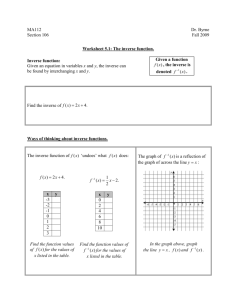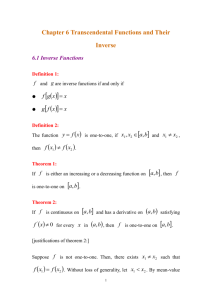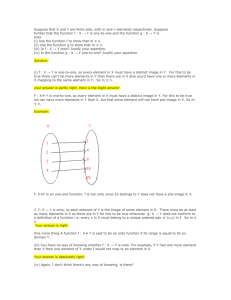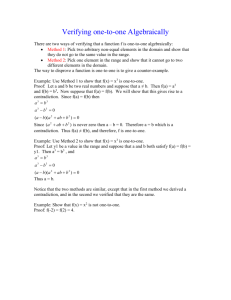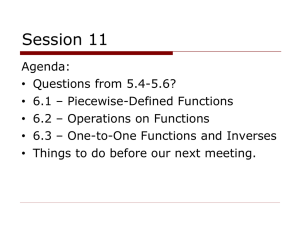3.6 SS
advertisement
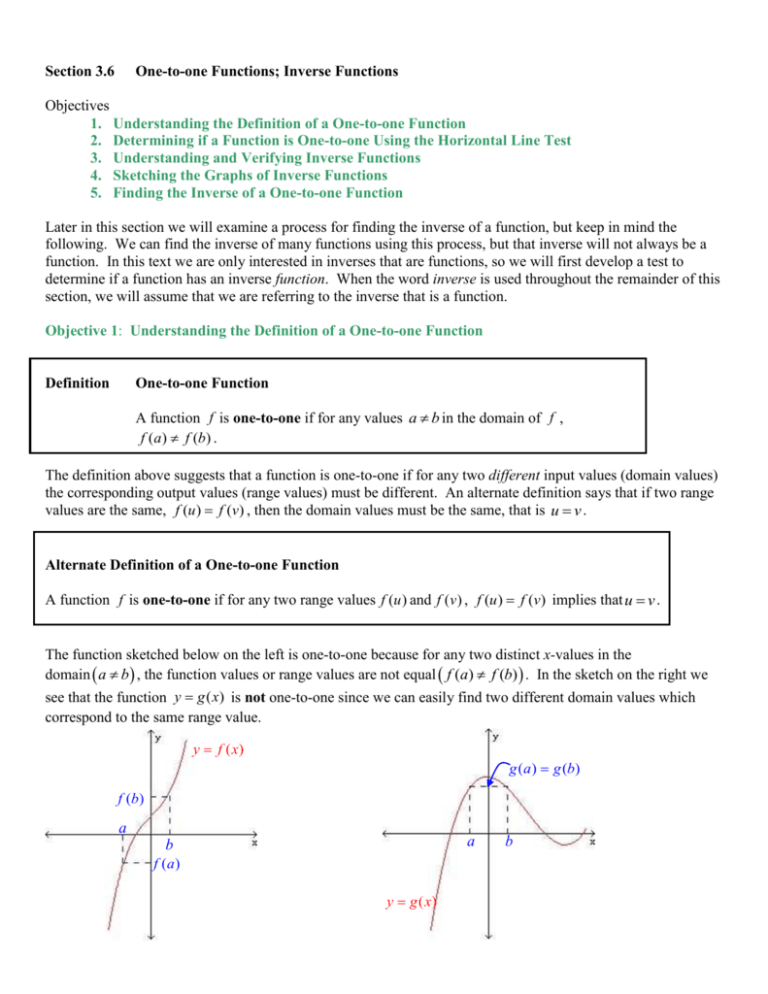
Section 3.6 One-to-one Functions; Inverse Functions Objectives 1. Understanding the Definition of a One-to-one Function 2. Determining if a Function is One-to-one Using the Horizontal Line Test 3. Understanding and Verifying Inverse Functions 4. Sketching the Graphs of Inverse Functions 5. Finding the Inverse of a One-to-one Function Later in this section we will examine a process for finding the inverse of a function, but keep in mind the following. We can find the inverse of many functions using this process, but that inverse will not always be a function. In this text we are only interested in inverses that are functions, so we will first develop a test to determine if a function has an inverse function. When the word inverse is used throughout the remainder of this section, we will assume that we are referring to the inverse that is a function. Objective 1: Understanding the Definition of a One-to-one Function Definition One-to-one Function A function f is one-to-one if for any values a b in the domain of f , f (a ) f (b) . The definition above suggests that a function is one-to-one if for any two different input values (domain values) the corresponding output values (range values) must be different. An alternate definition says that if two range values are the same, f (u ) f (v) , then the domain values must be the same, that is u v . Alternate Definition of a One-to-one Function A function f is one-to-one if for any two range values f (u ) and f (v ) , f (u ) f (v) implies that u v . The function sketched below on the left is one-to-one because for any two distinct x-values in the domain a b , the function values or range values are not equal f (a) f (b) . In the sketch on the right we see that the function y g ( x) is not one-to-one since we can easily find two different domain values which correspond to the same range value. y f ( x) g (a ) g (b) f (b ) a a b f (a) y g ( x) b Objective 2: Determining if a Function is One-to-one Using the Horizontal Line Test Any horizontal line intersects the graph of y f ( x) in at most one place, while we can find many horizontal lines that intersect the graph of y g ( x) more than once. This gives us a visual example of how we can use horizontal lines to help us determine from the graph if a function is one-to-one. Using horizontal lines to determine if the graph of a function is one-to-one is known as the horizontal line test. y f ( x) y g ( x) The Horizontal Line Test If every horizontal line intersects the graph of a function f at most once, then f is one-to-one. Objective 3: Understanding and Verifying Inverse Functions We are now ready to ask ourselves the question, “Why should we be concerned with one-to-one functions?” Answer: Every one-to-one function has an inverse function! Definition Inverse Function Let f be a one-to-one function with domain A and range B. Then f 1 is the inverse function of f with domain B and range A. Furthermore, if f (a ) b then f 1 (b) a . According to the definition of an inverse function, the domain of f is exactly the same as the range of f 1 and the range of f is the same as the domain of f 1 . The figure below illustrates that if the function f assigns a number a to b then the inverse function will assign b back to a. In other words if the point a, b is an ordered pair on the graph of f, then the point b, a must be on the graph of f 1 . Domain of f Range of f Range of f 1 Domain of f f •a •b f 1 1 Do not confuse f 1 1 1 . The negative 1 in f is NOT an exponent! f ( x) with Inverse functions “undo” each other. For example, it can be shown that if f ( x) x3 then the inverse of f is f 1 ( x) 3 x . Note that f 2 2 8 and f 1 8 3 8 2 . 3 The function f takes the number 2 to 8 while f 1 takes 8 back to 2. Observe what happens if we look at the composition of f and f 1 and the composition of f 1 and f at specified values: xvalue f f same as x value f 1 8 f f 1 (8) f 2 8 and xvalue 1 f 2 f 1 f (2) same as x value f 1 8 2 Because of the “undoing” nature of inverse functions, we get the following composition cancellation equations: Composition Cancellation Equations f f 1 ( x) x for all x in the domain of f 1 and f 1 f ( x) x for all x in the domain of f These cancellation equations can be used to show whether two functions are inverses of each other or not. We can see from our example above that if f ( x) x3 and f 1 ( x) 3 x then f f 1 ( x) f x x 3 3 3 x and f 1 f ( x) f 1 x3 3 x3 x Objective 4: Sketching the Graphs of Inverse Functions If f is a one-to-one function then we know that it must have an inverse function, f 1 . Given the graph of a one-to-one function f , we can obtain the graph of f 1 by simply interchanging the coordinates of each ordered pair that lies on the graph of f . In other words, for any point a, b on the graph of f , the point b, a must lie on the graph of f 1 . Notice below on the left that the points a, b and b, a are symmetric about the line y x . Therefore, the graph of f 1 is a reflection of the graph of f about the line y x . The figure on the right shows the graph of f ( x) x3 and f 1 ( x) 3 x . You can see that if the functions have any points in common, they must lie along the line y x . f ( x) x3 The graph of y f 1 ( x) The graph of f ( x ) x and f a one-to-one function and its inverse. 1 ( x) 3 3 x f 1 ( x) 3 x y f ( x) yx yx Objective 5: Finding the Inverse of a One-to-one Function We know that if a point ( x, y ) is on the graph of a one-to-one function, then the point ( y , x ) is on the graph of its inverse function. We can use this information to develop a process for finding the inverse of a function algebraically simply by switching x and y in the original function to produce its inverse function. To find the inverse of a one-to-one function, replace f ( x) with y, interchange the variables x and y then solve for y. This is the function f 1 ( x) . Inverse Function Summary 1. f 1 exists if and only if the function f is one-to-one 2. The domain of f is the same as the range of f 1 and the range of f 3. is the same as the domain of f 1 . To verify that two one-to-one functions f and g are inverses of each other we must use the composition cancellation equations to show that f g ( x) g f ( x) x . 4. The graph of f 1 is a reflection of the graph of f about the line y x . That is, for any 5. point a, b that lies on the graph of f, the point b, a must lie on the graph of f 1 . To find the inverse of a one-to-one function, replace f ( x) with y, interchange the variables x and y then solve for y. This is the function f 1 ( x) .

